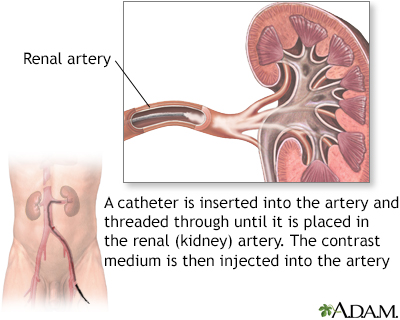Pregnancy SmartSiteTM
Renal angiogram; Angiography - kidney; Renal angiography; Renal artery stenosis - arteriography DefinitionRenal arteriography is a special x-ray of the arteries of the kidneys. How the Test is PerformedThis test is done in the hospital or outpatient office by a radiologist usually assisted by a technician or other staff members. You will lie on an x-ray table. Doctors often use an artery near the groin for the test. Occasionally, the doctor may use an artery in the wrist. Your doctor will:
The doctor directs the catheter into correct position using x-ray images of the body. An instrument called fluoroscope sends the images to a TV monitor, which the doctor can see. The catheter is pushed ahead over the wire into the aorta (main blood vessel from the heart). It then enters the kidney artery. The test uses a special dye (called contrast) to help the arteries show on the x-ray. The blood vessels of the kidneys are not seen with ordinary x-rays. The dye flows through the catheter into the kidney artery. X-ray images are taken as the dye moves through the blood vessels. Saline (sterile salt water) containing a blood thinner may also be sent through the catheter to keep blood in the area from clotting. The catheter is removed after the x-rays are taken. A closure device is placed in the groin or pressure is applied to the area to stop the bleeding. You may be asked to keep your leg straight for 4 to 6 hours after the procedure. How to Prepare for the TestTell your doctor if:
You must sign a consent form. DO NOT eat or drink anything for 6 to 8 hours before the test. You will be given a hospital gown to wear and asked to remove all jewelry. You may be given a pain pill (sedative) before the procedure or IV sedatives during the procedure. How the Test will FeelYou will lie flat on the x-ray table. There is usually a cushion, but it is not as comfortable as a bed. You may feel a sting when the anesthesia medicine is given. You may feel some pressure and discomfort as the catheter is positioned. Some people feel a warm sensation when the dye is injected, but most people cannot feel it. You don't feel the catheter inside your body. There may be slight tenderness and bruising at the site of the injection after the test. Why the Test is PerformedRenal arteriography is often done after other tests are done first. These may include duplex ultrasound, CT abdomen, CT angiogram, MRI abdomen, or MRI angiogram. These tests may show the following problems.
If these tests show problems renal arteriography may be used to guide a treatment such as embolization or arterial stent placement. Normal ResultsResults may vary. Talk to your health care provider about the meaning of your specific test results. What Abnormal Results MeanRenal angiography may show the presence of tumors, narrowing of the artery or aneurysms (widening of the vein or artery), blood clots, fistulas, or bleeding in the kidney. The test may also be done with the following conditions:
Some of these problems can be treated with techniques done at the same time the arteriogram is performed.
RisksThe procedure is generally safe. There may be some risks, such as:
There is low radiation exposure. Pregnant women and children are more sensitive to the risks related to x-rays. ConsiderationsThe test should NOT be done if you are pregnant or have severe bleeding problems. Magnetic resonance angiography (MRA) or CT angiography (CTA) can be done instead. MRA and CTA are noninvasive and can provide similar imaging of the kidney arteries, although they cannot be used for treatment. ReferencesAzarbal AF, Mclafferty RB. Arteriography. In: Sidawy AN, Perler BA, eds. Rutherford's Vascular Surgery and Endovascular Therapy. 10th ed. Philadelphia, PA: Elsevier; 2023:chap 27. Duddalwar VA, Jadvar H, Palmer SL. Diagnostic kidney imaging. In: Yu ASL, Chertow GM, Luyckx VA, Marsden PA, Skorecki K, Taal MW, eds. Brenner and Rector's The Kidney. 11th ed. Philadelphia, PA: Elsevier; 2020:chap 25. Textor SC. Renovascular hypertension and ischemic nephropathy. In: Yu ASL, Chertow GM, Luyckx VA, Marsden PA, Skorecki K, Taal MW, eds. Brenner and Rector's The Kidney. 11th ed. Philadelphia, PA: Elsevier; 2020:chap 47. | ||
| ||
Review Date: 1/29/2024 Reviewed By: Jason Levy, MD, FSIR, Northside Radiology Associates, Atlanta, GA. Also reviewed by David C. Dugdale, MD, Medical Director, Brenda Conaway, Editorial Director, and the A.D.A.M. Editorial team. View References The information provided herein should not be used during any medical emergency or for the diagnosis or treatment of any medical condition. A licensed medical professional should be consulted for diagnosis and treatment of any and all medical conditions. Links to other sites are provided for information only -- they do not constitute endorsements of those other sites. No warranty of any kind, either expressed or implied, is made as to the accuracy, reliability, timeliness, or correctness of any translations made by a third-party service of the information provided herein into any other language. © 1997- A.D.A.M., a business unit of Ebix, Inc. Any duplication or distribution of the information contained herein is strictly prohibited. | ||


 Kidney anatomy
Kidney anatomy Renal arteries
Renal arteries
